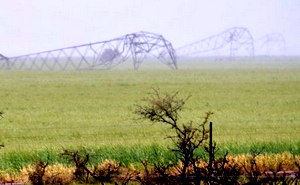 |
A string of record hot years have already had consequences in Australia. (Supplied: 350.org)
|
Instead, we're seeing the opposite.
While 2015-17 were all within the hottest six years on record, our carbon emissions also continued to increase during the same period, including an all-time peak in 2017, when unreliable land-use data was excluded from the analysis.
This is despite signing up to the Paris Agreement in 2015, which outlined a plan to reduce our carbon emissions by 26-28 per cent by 2030.
Government data pushed out under the cloak of Christmas indicates that we will be about 140 million tonnes — or about 30 per cent — above that target based on current growth.
And this is under the prime ministership of Malcolm Turnbull, who in 2010 warned that "the consequences of unchecked global warming would be catastrophic."
At the time, he argued that effective action on climate change required moving to "zero, or very near zero emissions [energy] sources.
"The science tells us that we have already exceeded the safe upper limit for atmospheric carbon dioxide."Forget Paris?
The aim of the Paris Agreement is to keep global temperature increase to "well below" 2 degrees, and to attempt to achieve a limit of 1.5 degrees warming above pre-industrial levels.
Last year averaged 0.95 of a degree above Australia's long-term average, the Bureau's Blair Trewin told RN yesterday.
He warns that the emissions we're producing today are setting in stone rising temperatures in the decades to come.
"We've got a warming trend of about a degree over the last century in Australia and all of the indications are that this will continue," he said.
"How much more warming we see: that depends on a number of things, but particularly what happens to greenhouse gas emissions over the coming decades."
Forests act as invaluable carbon sinks, yet in Queensland alone in 2015-16, 395,000 hectares of forest were cleared following the relaxation of land clearing laws under the Newman LNP government.
That number is feared to hit around a million hectares based on estimates from Queensland's self-assessment data, putting that state on par with Brazil.
And unreliable data on land clearing emissions mean we may actually be underestimating our carbon footprint.
The Federal Government has acknowledged that estimates of carbon emissions from land-use changes are difficult to gauge.
Emissions from land-clearing in Queensland totalled 45 million tonnes in 2015-16 according to state Environment Minister Steven Miles, but the Federal Government's estimates for the same period showed only a 1.7 million tonne change on the year prior.
Government optimism at odds with UN
Despite last financial year's continued emissions growth, Environment and Energy Minister Josh
 |
Josh Frydenberg remains optimistic about Australia achieving its Paris targets. (ABC News: Andrew O'Connor)
|
"If you look on a yearly basis that is true [that emissions went up]. But if you look on the last quarter, they went down. If you look at the trend, it is improving. And when you talk about the 2030 target, which is our Paris commitment, the numbers that were most recently shown, indicate that they were 30 per cent better than when Labor were last in office," the Minister told RN Breakfast.
But his optimism is at odds with a number of experts, and is contrary to what was reported in the United Nations Emissions Gap Report, 2017.
"Government projections indicate that emissions are expected to reach 592 [million tonnes] in 2030, in contrast to the targeted range of 429-440 [million tonnes]," the report states.
"Independent analyses confirm that the emissions are set to far exceed its Paris Agreement nationally determined contribution (NDC) target for 2030."
Generating electricity accounts for more than 30 per cent of Australia's emissions, and is also the area where great advances in technology are being made.
Currently more than 80 per cent of electricity going into the National Energy Market comes from fossil fuels.
An Australia Institute report from September last year argued that Australia could meet its 2030 Paris commitments if the electricity sector cut emissions by about 50 per cent below 2005 levels.
The report says that would mean moving to about 70 per cent renewable energy sources by 2030.
Business as usual won't get us to 2030 targets
But the appetite to back renewables isn't there.
"We're not looking at a target anywhere like that," Mr Frydenberg said.
"Dr Finkel, the chief scientist in the Finkel Review, made it very clear that if you take more than 26-28 per cent of the emissions out of the electricity sector it may have negative impacts on the stability and the security of the system."
The 2016 power outage in South Australia following a huge storm that downed three transmission lines was telling of some of the attitudes within the Government toward the renewable sector.
 |
Renewables were blamed for SA's power outage after storms in 2016. (ABC News: Tom Fedorowytsch)
|
"I regret to say that a number of state Labor governments over the years have set priorities and renewable targets that are extremely aggressive, extremely unrealistic, and have paid little or no attention to energy security," Malcolm Turnbull said at the time.
In contrast, both the Federal Government and Queensland Labor are avid in their support for establishing one of the world's largest coal mines in north Queensland.
The ABC unearthed evidence last year that shows Adani plans to export low-quality, high-ash coal to India that can cause deadly air pollution.
As 2030 approaches and the path to achieving our Paris commitments grows steeper, getting there will require more and more difficult management decisions, and more inconveniences to our way of life.
Disruptions to power supply become inevitable as the time to transition to a renewable energy market shrinks. How many power outages are people willing to put up with? How much revenue loss can we absorb?
To achieve an emission reduction of 26-28 per cent by 2030, it's time to admit that business as usual won't get us there. The sooner we do this, the smoother the approach can be.
Either that, or it's time to stop pretending we're on our way.
Links








